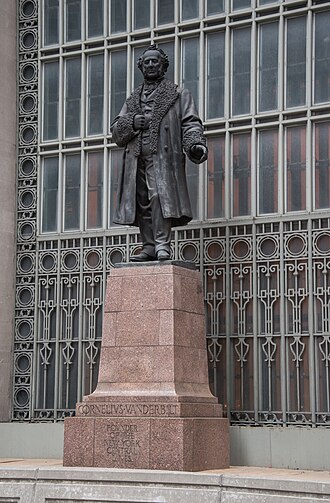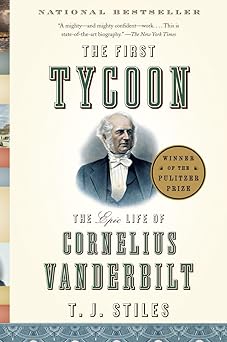Who was Cornelius Vanderbilt?
I ask the question in my headline because I am quite sure it is a question most Americans can no longer answer, with any firm knowledge. I myself didn’t know who Vanderbilt really was until I read a wonderful biography of him, The First Tycoon: The epic life of Cornelius Vanderbilt by T.J. Stiles, about two months ago.
Beforehand, all I really knew about Vanderbilt was that he had been a big deal somehow in the 1800s, and as a result there was a statue of him on the south side of Grand Central Station in New York, visible only by drivers going past on the overpass that circles the station.
What I learned from Stiles book however was astonishing. Not only did Vanderbilt build Grand Central Station, it was part of a transportation empire he created that by the end of his life covered most of the eastern United States. For Americans in the 1800s, if you needed to get from one place to another, you almost certainly rode on a Vanderbilt steamship or railroad.
Even more interesting to me however were the remarkable similarities in style, approach, and success between the Cornelius Vanderbilt of the 1800s and the Elon Musk of the 2000s. Both focused on taking new technology and making it profitable. Both built their empires on transportation.
And most of all, both focused on the product they were building to make money, not on speculating its value to make a quick buck.

Vanderbilt’s statue in front of Grand
Central Station. Click for source.
In Vanderbilt’s case, he began as a teenager growing up in Staten Island working on his father’s sailing boats. Much of their income came from transporting commuters to and from Manhattan. Vanderbilt soon expanded the business with his own boats. When steamships arrived he quickly transitioned to that new technology, establishing commuter lines all along the waterways from New York to Philadelphia to Boston to Albany. The Staten Island Ferry for example was created by Vanderbilt, not the New York City government.
As this business grew he linked it with ground transportation, first wagons, then railroads. Railroads required gigantic amounts of capital, and thus forced the establishment of the first large corporations, using stock sales to raise that capital. Not surprisingly, many railroad executives saw the manipulation of the railroad stock as their prime method of getting rich. They didn’t care if they ran their railroad into the ground, and in fact, often did exactly that, if it allowed them to cash in.
Vanderbilt was different. When he financed a new railroad, or purchased its stock, it wasn’t to speculate on the stock. It was to make that railroad a profitable operation, serving its customers with reasonable fares and getting where they wanted to go as quickly as possible. Often he gained control of one of those badly run lines and quickly reorganized it, making it profitable once again.
And in this task Vanderbilt was remarkably successful. By the time he died in 1877 he was the richest man in America, his wealth so large it was difficult at that time to measure it. His railroads provided the main transportation from Chicago across the entire northeast of the United States.
Vanderbilt’s story was even more fascinating to me because of its uncanny parallels with that of Elon Musk. Like Vanderbilt, Musk started small, but at every step used new technology to create products needed by the general public. First it was Paypal, then it was SpaceX and rocketry. Next it was electric cars, followed by large scale municipal tunnel digging and robots.
In every case however Musk has had no interest in speculation. His goal was to make a good product, one that people wanted to buy because it provided what they needed at less cost than his competitors while doing it better.
And like Vanderbilt, Musk built his empire based on the American concept of freedom and capitalism. The goal was to make money, creating new products. The route to do so was through each man’s personal creativity, following his own personal dreams.
In the 1800s Vanderbilt was largely free to do whatever he wanted. The government had little regulatory control of his actions. His general honesty, combined with a ruthless competitive spirit, resulted in great success.

Musk entering Twitter headquarters for the first time,
carrying a kitchen sink. His message: I’m cleaning house!
In the 2000s Musk has not had as free a hand as Vanderbilt. Our modern administrative state controls too much of American business. Musk has either had to feed off its trough, or fight it tooth and nail to get it out of his way. For Tesla he relied on government subsidies. With SpaceX he had to sue the Air Force to allow it to bid on military launch contracts. With Starship he had to become political to kick the Democrats controlling the White House out of power, because their red tape during the Biden years was suffocating him.
And when Twitter was squelching the free speech of conservatives, Musk simply bought it and reshaped it to do its job right, making X now one of the best bastion’s of free speech in the technological world.
But like Vanderbilt, Musk has no interest in political power. Vanderbilt always avoided politics, at all costs. The only time he involved himself in Washington was during the Civil War, when he donated his largest ship to the Union effort. As Stiles noted,
An honest reading of the evidence shows a proud, prickly, and highly capable man of immense personal force–one who was also deeply patriotic. … When given the chance, he served his country to the utmost while refusing any remuneration.
One could easily apply this description quite accurately to Elon Musk. He didn’t campaign for Trump because he hoped it would win him government contracts. He did it because he saw Trump as the best option for America. That it might help his own businesses was of course likely, but that possibility was clearly not Musk’s prime motive during last year’s election campaign.
And once that campaign was over? Like Vanderbilt, Musk abandoned politics to go back to his private businesses.
Vanderbilt’s history, as well as Musk’s, illustrates the greatest aspect of America. It truly is a place that supports “life, liberty, and the pursuit of happiness.” You certainly can do bad things with that freedom, but if you make morality and doing good works as your fundamental goals, that freedom will allow you to do great things.
Vanderbilt, and Musk, prove this. We would be wise if we all emulated them.
On Christmas Eve 1968 three Americans became the first humans to visit another world. What they did to celebrate was unexpected and profound, and will be remembered throughout all human history. Genesis: the Story of Apollo 8, Robert Zimmerman's classic history of humanity's first journey to another world, tells that story, and it is now available as both an ebook and an audiobook, both with a foreword by Valerie Anders and a new introduction by Robert Zimmerman.
The print edition can be purchased at Amazon or from any other book seller. If you want an autographed copy the price is $60 for the hardback and $45 for the paperback, plus $8 shipping for each. Go here for purchasing details. The ebook is available everywhere for $5.99 (before discount) at amazon, or direct from my ebook publisher, ebookit. If you buy it from ebookit you don't support the big tech companies and the author gets a bigger cut much sooner.
The audiobook is also available at all these vendors, and is also free with a 30-day trial membership to Audible.
"Not simply about one mission, [Genesis] is also the history of America's quest for the moon... Zimmerman has done a masterful job of tying disparate events together into a solid account of one of America's greatest human triumphs."--San Antonio Express-News



I’ve thought long and hard about trying to identify a 19th century equivalent to Elon Musk, either in Britain or America. And I haven’t found anyone who quite fits the bill.
But there are a handful of men who anticipate certain aspects of Elon in different ways. Cornelius Vanderbilt is most certainly one of them. He was a great American success story, one who contributed in a very meaningful way to America’s success, too. He deserves to be remembered more than he is.
Brunel’s Great Eastern was the Starship of its day and then some….but that ship was based on the opposite of “the best part is no part” since it had paddlewheels propellors and sails…so more B-36, I suppose.
People had no fear of size then… something space launch had an issue with until recently.
For the longest time in the USA, our philosophy was to miniaturize the payload. The Soviet Chief Designers were actually closer to Brunel in that their approach was “make the rocket bigger.”
R-7 was the result…and now available as an Estes rocket.
To this day, there are folks even in NewSpace that still balk at the SHLLV concept.
Now while I must have my little jokes at Elon’s expense from time to time, I truly appreciate the fact that he understands the need for LV growth.
Trucks, ships and planes have increased in size–but for the longest time, rockets stayed in the Delta family payload range.
This small-mindedness still lives in the heads of many… something hard for Brunel and Elon to overcome.
Vanderbilt was perhaps more of a Warren Buffet of his age, with Brunel more of a visionary like Musk.
I think Brunel was the most brilliant engineer of the 19th century (and I am not alone in thinking this!), but I think the problem he ran into with Great Eastern is that he was entering a transportation field (maritime steam propulsion) that was much less mature in 1854 than orbital rocketry was in 2002. Worse, he went in “big,” with the largest vessel ever built, so the risk was even higher. The immaturity of that technology meant that he felt compelled to use two propulsion systems (one screw propeller and two paddle wheels), and using sails as auxiliary power, which was common practice at that time with sea-going steam vessels.* No one had ever made twin screws work consistently yet, let alone at scale.
I think he would have worked it out with screw propulsion even after Great Eastern failed, but his tobacco habit cut his life tragically short before he had the chance.
* For context, the US Navy and Britain’s Royal Navy were just starting to get seriously into steam propulsion at this point in time; but warships which they had built or converted to have steam power plants all used single screws, and they only used the screws as *auxiliary* propulsion, with sailpower still their mainstays. With Great Eastern, it was the other way around.